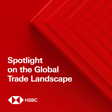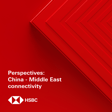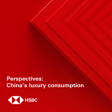Become a Creator today!Start creating today - Share your story with the world!
Start for free
00:00:00
00:00:01

The Macro Brief – India’s global integration
Pranjul Bhandari, Chief India Economist, examines India’s interconnectedness with the global economy and considers whether the redrawing of supply chains could present new opportunities.
Disclaimer: https://www.research.hsbc.com/R/101/bHlntgR
Stay connected and access free to view reports and videos from HSBC Global Research follow us on LinkedIn https://www.linkedin.com/feed/hashtag/hsbcresearch/or click here: https://www.gbm.hsbc.com/insights/global-research.
Transcript
Introduction to Podcast Series
00:00:02
Speaker
Welcome to HSBC Global Viewpoint, the podcast series that brings together business leaders and industry experts to explore the latest global insights, trends, and opportunities.
00:00:13
Speaker
Make sure you're subscribed to stay up to date with new episodes. Thanks for listening. And now onto today's show.
00:00:23
Speaker
This podcast was recorded for publication on the 30th of May 2025 by HSBC Global Research. All the disclosures and disclaimers associated with it must be viewed on the link attached to media player.
00:00:34
Speaker
And don't forget to like and subscribe to The Macrobrief wherever you get your podcasts.
Focus on India's Economy
00:00:44
Speaker
Hello, I'm Piaz Butler and this is the Macrobrief, where we look at the issues driving financial markets across the globe. With an annual GDP growth rate of over 6% and a population of nearly 1.5 billion people, India is one of the fastest growing economies in the world.
00:01:00
Speaker
Now, many people think that it is a mainly domestic driven economy. But is this true? Today, we're assessing just how integrated India is globally, and whether the redrawing of supply chains could present some new opportunities.
Discussion with Pranjal Bhandari
00:01:14
Speaker
To do that, I'm joined by Pranjal Bhandari, Chief India Economist. Pranjal, it's been a while since we've spoken to you. Welcome back on the podcast. Great to be here, Piers. So ah why don't we start off by talking him about this perception that India is a domestically driven economy. Why do you, in your latest report, disagree with that? After all, agriculture is, if I'm right, still a really important component of GDP at close to 20%.
00:01:41
Speaker
Yes, you're right, Piers. There's a sense that India is mostly a domestic demand economy. But, you know, I want to put in a a different perspective to this. My sense is that in years or in decades, when India has tried to integrate faster with the world, it's been able to produce higher GDP growth.
00:01:58
Speaker
And in years and decades, when it has slowed down, it's become a bit more protectionist, it's actually seen much lower GDP growth. So higher integration with the world has actually, you know, made India grow faster.
00:02:09
Speaker
You know, my best example is the decade 2000 to 2010, when import tariffs were being slashed. India was gaining in global export market share. It was growing at about 8%. And then came the next decade in which it was raising tariff rates across the world.
00:02:24
Speaker
It became a lot more protectionist. Its global integration fell and GDP growth slowed to about 6%. So let's drill down on that. How does that break down between the sort of big components of the economy? That is consumption, investment and exports.
00:02:39
Speaker
Yeah, this is where we find some some surprising results. you know, we find that India is more integrated with the world in consumption, followed by investment, and least so in exports.
00:02:51
Speaker
Now, this is a bit counterintuitive. You know, you would expect that exports are more globally driven, so the integration should be more... But what we found in India is that within global integration, it has integrated a lot more financially with financial markets.
00:03:06
Speaker
If you look at the equity markets in India and you correlated with the S&P 500, it's really mapping very closely in the last couple of decades. But trade integration has been a tad slower in comparison.
00:03:19
Speaker
So everything that benefits from financial integration, such as high-end consumption, has done very well. But everything that that depends on trade, for example, exports of textiles, footwear, they haven't done that well.
00:03:33
Speaker
So stronger finance integration and weaker trade
India's Global Trade Potential
00:03:37
Speaker
integration. But in your report, you see an opportunity on trade on the back of the increase in tariffs by the Trump administration. And to use ah your word, that also sounds counterintuitive. So perhaps you could explain why you see that opportunity.
00:03:52
Speaker
Yes, that's right. So look, I think n India is quite integrated financially. It's trade where it can do more and therefore grow faster. Now, how do you integrate more closely with the world when global trade is under some threat?
00:04:05
Speaker
And I agree with you, that's a bit counterintuitive, but I actually very strongly believe it's India's big opportunity. Now, let me explain why. You know, we're seeing that in the Trump-Wanna administration, a lot of the tariff rates were changed.
00:04:17
Speaker
and supply chains got rejigged. ah There were many countries which actually benefited. They became new manufacturing hubs. Many of them were in ASEAN part of the world. ah India wasn't a big beneficiary at that point of time.
00:04:31
Speaker
If right now, once the current tariff uncertainty subsides, you know we have new rules of the game, ah supply chains are redrawn once again, countries like India could actually benefit this time around.
00:04:44
Speaker
So my sense is that once the storm settles, India could benefit in a way it did not benefit five or six years ago. Yes, and you make the point in your report that on the back of the Trump one tariff measures, ah other countries seized the opportunity such as Vietnam. So what does India need to do this time around in order to seize the the opportunity? Are there reforms that are required to be implemented in order for that to happen?
Key Economic Reforms in India
00:05:10
Speaker
Yeah, absolutely, Piers, and I'm glad you asked this because I think there are four very important things India seems to be doing right this time around. One, it's actually cutting tariff rates. you know At a time when other countries are raising them, India is cutting tariff rates in a variety of goods and basically giving a signal to the world that it is open for trade. It's not protectionist.
00:05:32
Speaker
The second thing it's doing, it's fast tracking a lot of the trade agreements, particularly with advanced economies. it It ended one with with the UK a couple of months ago. It's working on one with the US, another one with EU, which and both of them, it plans to finish this year.
00:05:48
Speaker
This is a big change in policy for India. You know, earlier India used to take a long time to get any trade agreements done. This time it has a faster approach. The third area is being a little more open to FDI.
00:06:00
Speaker
Now, this is very important because just recently, China has become a big giver of FDI. So it's going to be very important ah for India to become a taker of FDI and then it can benefit with this big regional FDI flows that are happening in Asia.
00:06:16
Speaker
And we're seeing some initial signs of India being a little more open to Chinese FDI. And then finally, there's a flexible exchange rate. ah It can be argued that in the last couple of years, India's exchange rate was not very flexible, but it has changed in the last few months. And a flexible exchange rate does give confidence to manufacturers who want to set shop ah you know in the country. So I think India is doing taking some right steps, but it's going to be very important for the country that these reforms run deep.
00:06:47
Speaker
And just to come back on this point on FDI, which is foreign direct investment, can you give us a bit of an illustration of what that means in practical terms? Yeah. So, so look, you know, I like to break it down into two parts.
00:07:00
Speaker
ah FDI into high tech sectors like semiconductors, green hydrogen, you know, all of these futuristic sectors. And then FDI in mid tech sectors, you know, more consumer goods like textiles, footwear,
00:07:13
Speaker
apparel, ah toys, and things like that. Now, in the past, India has tried to attract a lot of high-tech FDI, ah and it it has ignored mid-tech FDI.
00:07:23
Speaker
And I think it's very important for India to change track at this point of time, and I'm seeing signs of that as well. India's becoming a lot more open to attracting mid-tech FDI in areas which are actually a lot more labor-intensive.
00:07:37
Speaker
And this will be good for India's growth, but it'll also create the vast number of jobs India needs in the next decade. And a big giver of this FDI is actually China. You know, there was a huge amount of Chinese FDI going to Vietnam five, six years ago.
00:07:51
Speaker
If India can get a pie of that in the next couple of years, I think India has much to gain.
Job Creation and Manufacturing Focus in India
00:07:56
Speaker
Now, you mentioned this um this challenge by India to create jobs. And in in fact, one of our previous conversations was all about how India had on the one hand this fantastic advantage of a very young ah working population, but at the same time that there was obviously ah challenge to provide jobs for that for that population. and And last month, you published a report entitled Resetting India's Growth Equation. So maybe can we sort of recap on that previous conversation and what you mean by resetting India's growth equation?
00:08:28
Speaker
Yeah, so look, of this year is going to be a lot more consumption driven instead of investment driven, simply because there's a huge amount of uncertainty around the world. ah But our sense is that once the storm settles, new rules of the games emerge from next year onwards, hopefully, investment will start to revive again.
00:08:47
Speaker
And that's what we call a big reset in India's growth, that you know this time this year it's fine to be more consumption driven, but next year you really want investment to start you know kicking back up again. And here we are hoping that India can make a foray into mid-tech manufacturing, something which probably in the past India has hasn't done very well.
00:09:07
Speaker
You know, it probably went up the value chain quite well in services exports. So it started off as a call center. It then started doing more value-added stuff like software solutions, cloud computing. Today, it's selling all kinds of professional services around the world, like medical, accounting, legal services.
00:09:25
Speaker
We need the same magic in manufacturing as well. We need to rise up. you know We need to get from low tech to mid tech, textiles, footwear, and eventually get to things like like green hydrogen and and chips and EVs.
00:09:38
Speaker
So if we can if it can do the same magic in manufacturing and get the right investment going from next year, I think it'll be very important for it to create the jobs. And how do you feel about that if we just update ourselves in that conversation that we had?
00:09:50
Speaker
How optimistic are you that India will ultimately rise to the challenge of creating enough jobs for this young young working population? Well, Piers, you know, the challenge is immense. India has to create 70 million jobs in the next decade.
00:10:04
Speaker
My sense is if it can, you know, do it like do two thirds right, it's it's probably a good outcome. I feel a little more positive about it right now than I was feeling about like a few years ago, because I can feel this sense of urgency.
00:10:19
Speaker
And I can see that there's a sense that, you know, with global supply chains rejigging again, it's an opportunity for India to get into mid-tech manufacturing, which, by the way, is a huge source of jobs and in which, you know, MNCs are actually looking for new countries to produce in.
Current Economic Indicators
00:10:35
Speaker
um I just wanted to finish on ah this other report that you published, the latest edition of 100 indicators of growth. I don't know how you have time to keep track of 100 indicators, but what what do those indicators tell us about the state of the ah India economy at the present day?
00:10:52
Speaker
Yeah, well, Piers, know, it's all automated. So it's not that painful. But it's truly interesting because we can actually update it every single day. Something gets updated every day. And then we map it all to different sectors of GDP growth. And it gives us a very good sense on where growth is headed.
00:11:08
Speaker
So what we're finding right now is that the March quarter has been a little better than the previous two quarters. That is surprising, right? At a time when you know and uncertainty is rising, we are seeing India's March quarter being better than the previous two quarters.
00:11:22
Speaker
What's really happening is that inflation has fallen very sharply. And what it's doing is that it's increasing real purchasing power, particularly of mass consumers who are very sensitive to inflation.
00:11:35
Speaker
And that is allowing many of these people to consume more because they are feeling richer. And I think on the back of that, our senses that GDP growth will be a little better in March than in the previous two quarters.
00:11:47
Speaker
Pranjal, I think that's all we have time for. Thank you again for updating us on on India and the longer term prospects. I'm sure we will have you back on soon. ah But in the meantime, good luck with the rest of your marketing and thank you for taking the time to join us today.
00:12:01
Speaker
ah Great to be on your show, Piers. Thank you so much for having me.
00:12:07
Speaker
Now, in last week's macro brief, we discussed whether the U.S. is losing global investor flows from its equity
Further Listening and Engagement
00:12:13
Speaker
markets. If you'd like to know more about the picture on the other side of the globe, listen to our sister podcast, Under the Banyan Tree.
00:12:20
Speaker
This week, Harold van der Linde sits down with equity strategist Perona Garg to discuss what mainland Chinese savers could do with a mind-bending $22 trillion dollars in savings and the implications for markets at home and beyond.
00:12:34
Speaker
Remember that HSBC clients can keep up to date with our latest research by downloading our app from Apple's App Store or Google Play. And we'd love to hear from you. So if you have any questions or comments about anything we've talked about today, you can email us at askresearch at hsbc.com.
00:12:52
Speaker
Finally, if you've enjoyed today's podcast, then please like and subscribe. but And share it with friends and colleagues.
00:13:00
Speaker
So that's it for this week's macro brief. Thanks very much for listening, and we'll be back again next week.
00:13:29
Speaker
Thank you for joining us at HSBC Global Viewpoint. We hope you enjoyed the discussion. Make sure you're subscribed to stay up to date with new episodes.
















